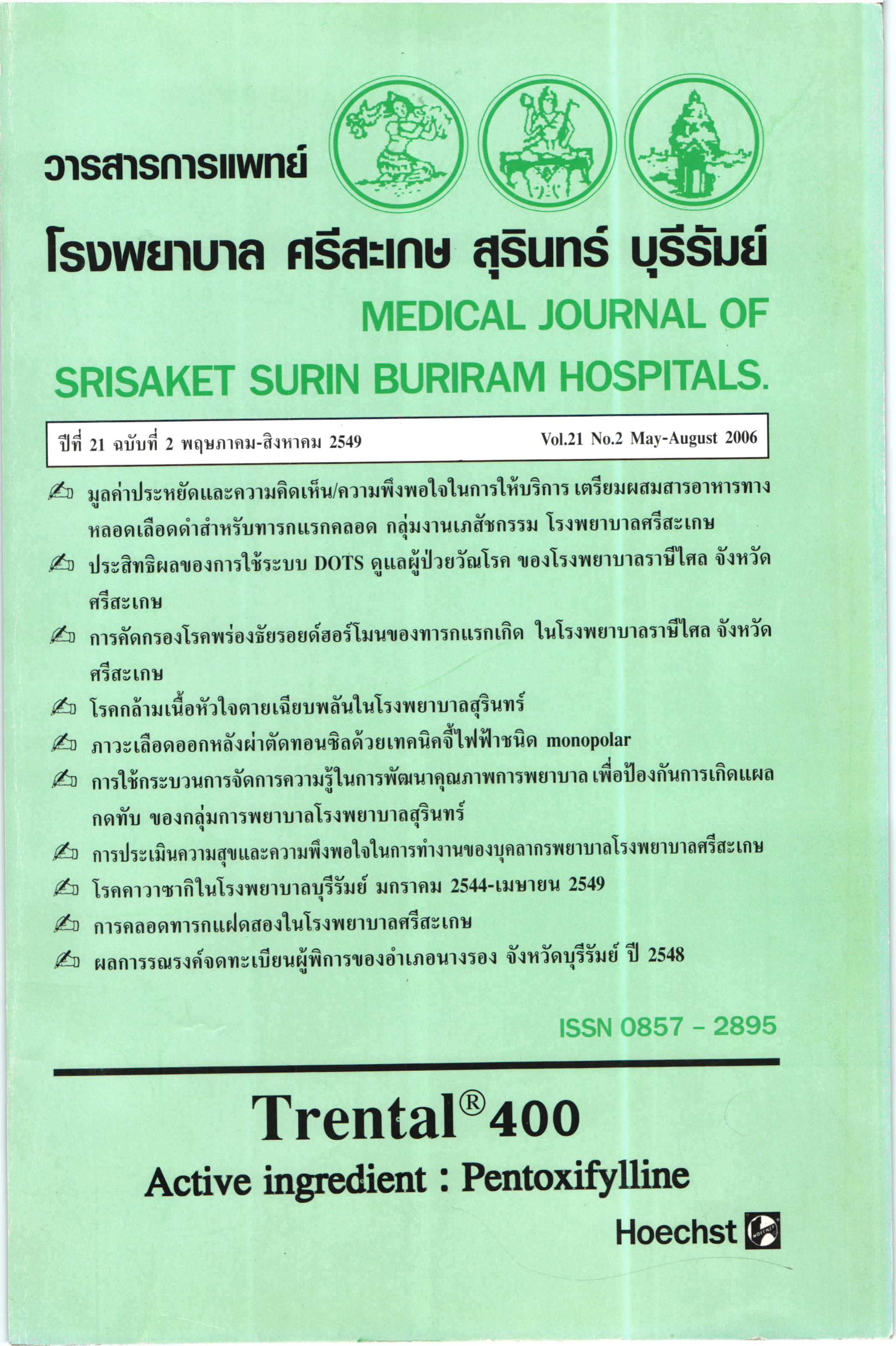โรคคาวาซากิในโรงพยาบาลบุรีรัมย์ มกราคม 2544-เมษายน 2549
Main Article Content
บทคัดย่อ
เหตุผลการวิจัย: โรคคาวาซากิเป็นสาเหตุหนี่งของโรคหัวใจที่เป็นภายหลังเกิดในเด็ก พบผู้ป่วยโรคนี้เพิ่มขึ้นเรื่อยๆ ในต่างประเทศโดยเฉพาะประเทศในแถบทวีปเอเชีย ในประเทศไทยก็มีแนวโน้มจำนวนผู้ป่วยเพิ่มขึ้นเช่นกัน ผู้ป่วยที่ไม่ได้รับการรักษามีโอกาสเกิดความผิดปกติของหลอดเลือดโคโรนารีได้ถึงร้อยละ 15-25 เนื่องจากไม่มีการตรวจยืนยันที่แน่นอนสำหรับโรคนี้ การวินิจฉัยจึงอาจยังเป็นปัญหาโดยเฉพาะในจังหวัดบุรีรัมย์ซึ่งเป็นแหล่งชุกชุมของโรคติดเชื้อทางเขตร้อนต่าง ๆ ที่ต้องน่ามาพิจารณาแยกโรคร่วมด้วย
วัตถุประสงค์: เพื่อศึกษา ระบาดวิทยาของโรค ลักษณะทางคลินิก การรักษาและผลการรักษาของผู้ป่วยโรคคาวาชากิในโรงพยาบาลบุรีรัมย์
ผู้ป่วยและวิธืการ: ทำการศึกษาย้อนหลังเชิงพรรณนา จากเวชระเบียนผู้ป่วยในของโรงพยาบาล บุรีรัมย์ ที่ได้รับการวินิจฉัยว่าเป็นโรคคาวาชากิ ตั้งแต่ 1 มกราคม พ.ศ. 2544-31 เมษายน พ.ศ.2549
ผลการศึกษา: ผู้ป่วยทั้งหมด 12 ราย อัตราส่วน ชาย:หญิง 1.4:1 อายุตั้งแต่ 6 เดือนถึง 4ปี 6เดือน (เฉลืย 25 เดือน) พบจำนวนผู้ป่วยมากขึ้นในช่วงฤดูร้อน มีผู้ป่วยที่แสดงอาการไม่ครบ 6 ราย (50.0%) มีผู้ป่วย 1 ราย (8.33%) มาด้วยอาการ หัวใจวายเลือดคั่ง ส่วนใหญ่ได้รับแกมมาโกลบุลิน (IVIG) ในระยะแรกของโรค มี 2 ราย (16.66%) ไม่ได้รับ IVIG เนื่องจากวินิจฉัยล่าช้า ส่วนใหญ่ไข้ลง ภายใน 24-48 ชั่วโมง แต่มีผู้ป่วย 1 รายมีไข้ถึง 7 วันหลังได้ IVIG โดยไม่ได้ IVIG ซ้ำผู้ป่วยที่มีอาการและอาการแสดงของโรคซ้ำ 2 ราย (16.66%) ได้รับการวินิจฉัยล่าช้าและได้ IVIG ในขนาดไม่เหมาะสมในการรักษาครั้งแรก ได้ส่งผู้ป่วยไปรักษาต่อที่โรงพยาบาลอื่นเนื่องจากอาการไม่ดีขึ้น 3 ราย (25.0%) ผู้ป่วยที่เหลือตรวจไม่พบความผิดปกติของหลอดเลือดโคโรนารี
สรุป: แม้โรคคาวาซากิเป็นโรคที่พบไม่บ่อยนัก แต่ผู้ป่วยมีโอกาสเสี่ยงต่อการเกิดภาวะแทรกซ้อนที่อันตรายหากได้รับการรักษาล่าช้าหรือไม่ได้รับการรักษา แพทย์ควรนึกถึงโรคนี้เสมอในการวินิจฉัยแยกโรคเด็กที่มาด้วยอาการไข้สูงแม้ผู้ป่วย ยังไม่มีอาการครบทุกข้อตามหลักเกณฑ์
Article Details
เอกสารอ้างอิง
2. Newburger JW, Taubert KA, Shulman ST et al. Summary and abstracts of the Seventh International Kawasaki Disease Symposium. Pediatr Res. 2003;53:153-7.
3. สุมาลี ศรีวัฒนา, สุวรรณี ตั้งทูลสินธนา, โชติมา บัทมานนท์, ศักดิ์ เตชางาม. โรคคาวาชากิ. แพทยสภาสาร 2519;5:550-7
4. Panamonta M, Chaikitpinyo A, Durongpisitkul K et al. Kawasaki disease in central area of Northeast Thailand. J Med Assoc Thai. 2004;87:887-90.
5. Council on Cardiovascular Disease in the Young, Committee on Rheumatic Fever, Endocarditis, and Kawasaki Disease, American Heart Association. Diagnostic Guidelines for Kawasaki Disease. Circulation. 2001;103:335-336.
6. Kato H, Sugimura T, Akagi T et al. Long-term consequences of Kawasaki disease. A 10- to 21-year follow-up study of 594 patients. Circulation. 1996:94:1379-85.
7. Yoshikawa H, Nomura Y, Masuda K et al. Four cases of Kawasaki syndrome complicated with myocarditis. Circ J. 2006;70:202-5.
8. Tsuda E, Arakaki Y, Shimizu T et al. Changes in causes of sudden deaths by decade in patients with coronary arterial lesions due to Kawasaki disease. Cardiol Young. 2005;15:481-8.
9. Newburger JW, Takahashi M, Bums JC et al. The treatment of Kawasaki syndrome with intravenous gamma globulin. N Engl J Med. 1986;315:341-7.
10. Peduzzi TL, Pitetti RD. Myocardial infarction and atypical Kawasaki disease in a 3-month-old infant. Pediatr Emerg Care. 2002;18:e16-9.
11. Hsieh YC, Wu MH, Wang JK et al. Clinical features of atypical Kawasaki disease. J Microbiol Immunol Infect. 2002 ; 35:57-60.
12. Tiao MM, Huang LT, Liang CD, Ko SF. Atypical Kawasaki disease presenting as intestinal pseudo¬obstruction. J Formos Med Assoc. 2006;105:252-5.
13. Diana MC, Villa G, Gattomo M et al. Sudden death in an infant revealing atypical Kawasaki disease. Pediatr Emerg Care. 2006;22:35-7.
14. Witt MT, Minich LL, Bohnsack JF, Young PC. Kawasaki disease: more patients are being diagnosed who do not meet American Heart Association criteria. Pediatrics. 1999;104:e10.
15. Pannaraj PS, Turner CL, Bastian JF, Burns JC. Failure to diagnose Kawasaki disease at the extremes of the pediatric age range. Pediatr Infect Dis J. 2004;23:789-91.
16. Anderson MS, Todd JK, Glode MP. Delayed diagnosis of Kawasaki syndrome: an analysis of the problem. Pediatrics. 2005;115:e428-33.
17. Dajani AS, Taubert KA, Gerber MA et al. Diagnosis and therapy of Kawasaki Disease in children. Circulation. 1993;87:1776-80.
18. Guo- Ying Huang, Xiao-Jing Ma, Min Huang et al. Epidemiologic pictures of Kawasaki disease in Shanghai from 1998 through 2002. J Epidemiol 2006;16:9-14.
19. YM Ng, RYT Sung, LY So et al. Kawasaki disease in Hong Kong, 1994 to 2000. Hong Kong Med J 2005;11:331-5.
20. Mason WH, Takahashi M. Kawasaki syndrome. Clin Infect Dis 1999;28:169-85.
21. Brogan PA, Bose A, Burgner D et al. Kawasaki disease: an evidence based approach to diagnosis, treatment, and proposals for future research. Arch Dis Child 2002;86:286-90.
22. G. Simonini, CD Rose, A Vierucci et al. Diagnosing Kawasaki syndrome: the need for a new clinical tool. Rheumatology 2005;44:959-961.84
23. Mark TW, LuAnn M, John FB, Paul CY. Kawasaki Disease: More patients are being diagnosed who do not meet American Heart Association criteria. Pediatrics 1999;104:e10.
24. Newburger JW, Takahashi M, Gerber MA et al. Diagnosis, treatment, and long-term management of Kawasaki disease: a statement for health professionals from the committee on Rheumatic fever, Endocarditis, and Kawasaki disease, Council on Cardiovascular Disease in the Young. American Heart Association. Pediatrics 2004;114:1708-33.
25. Hirata ร, Nakamura Y, Matsumoto K, Yanagawa H. Long-term consequences of Kawasaki disease among first-year junior high school students. Arch Pediatr Adol Med 2002;156:77-80.
26. M Iemura, M Ishii, T Sugimura et al. Long-term consequences of regressed coronary aneurysms after Kawasaki disease: vascular wall morphology and function. Heart 2000;83:307-311.
27. Senzaki H, Chen CH, Ishido H. Arterial hemodynamics in patients after Kawasaki disease. Circulation 2005;111:2119-25.
28. Tsuda E, Kamiya T, Ono Y et al. Dilated coronary arterial lesions in the late period after Kawasaki disease. Heart 2005;91:177-82.
29. Parisi Q, Abbate A, Biondi-Zoccai GG et al. Clinical manifestations of coronary aneurysms in the adult as possible sequelae of Kawasaki disease during infancy. Acta Cardiol. 2004;59:5-9.
30. Bartoloni G, Salvatrice DM, Carlo R. Sudden death in a 21-year-old man caused by thrombosed coronary aneurysm: late sequelae or a very late onset of Kawasaki disease? Cardiovasc Pathol. 2002;11:318-21.
31. Seve P, Stankovic K, Smail A et al. Adult Kawasaki disease: report of two cases and literature review. Semin Arthritis Rheum. 2005;34:785-92.
32. Fason JT, Fry YW, Smith D. Kawasaki disease in a postpartum patient. J Natl Med Assoc 2004;96:1499-502.(abstract)
33. Smith BA, Grider DJ. Sudden death in a young adult: sequelae of childhood Kawasaki disease. Am J Emerg Med 1993;11:381-3.


